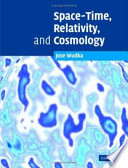 Newton's law of gravitation states that any two bodies attract each other with a force proportional to the product of their masses and inversely proportional to the square of the distance between them... Newton's law of gravitation states that any two bodies attract each other with a force proportional to the product of their masses and inversely proportional to the square of the distance between them...  An Introduction to Mathematics - 28. lappuseautors: Alfred North Whitehead - 1911 - 256 lapasPilnskats An Introduction to Mathematics - 28. lappuseautors: Alfred North Whitehead - 1911 - 256 lapasPilnskats - Par šo grāmatu
 | G. C. Ghirardi - 2005 - 524 lapas
...attraction. Newtonian physics assumes that all bodies endowed with mass exert an attraction on other bodies with a force proportional to the product of their masses and inversely proportional to the square of the distance between the two bodies. Although he was very concerned over this problem, Newton... | |
 | Haym Benaroya, Seon Mi Han, Mark Nagurka - 2005 - 770 lapas
...generalization led Newton to the law of universal gravitation: ... all matter attracts all other matter with a force proportional to the product of their masses and inversely proportional to the square of the distance between them. Newton explained a wide range of previously unrelated phenomena:... | |
 | Cutler J. Cleveland, Christopher G. Morris - 2005 - 512 lapas
...the first recorded definition of the term energy in English). "All matter attracts all other matter with a force proportional to the product of their masses and inversely proportional to the square of the distance between them." — Sir Isaac Newton, English scientist (1687; describing his... | |
 | Barbara Louv - 2006 - 112 lapas
...mutually attract each other by the law of universal gravitation. . ."All matter attracts all other matter with a force proportional to the product of their masses and inversely proportional to the square of the distances between them." It was difficult for other scientists to accept the idea of... | |
 | Jose Wudka - 2006 - 307 lapas
...the several quantities of matter which they contain. Translated this means, "any two bodies attract with a force proportional to the product of their masses and inversely proportional to the distance between them" which is precisely what the above equation states. Having discovered this Newton... | |
 | Donald Fenna - 2006 - 512 lapas
...(usually denoted g). Newton's Universal Law of Gravitation states that two bodies attract each other with a force proportional to the product of their masses and inversely to the square of their distance apart. Because force equals mass times acceleration, we can equivalently... | |
 | Douglas C. Giancoli - 2008 - 1103 lapas
...law of universal gravitation states that every particle in the universe attracts every other particle with a force proportional to the product of their masses and inversely proportional to the square of the distance between them: F = G (6-1) The direction of this force is along the line joining... | |
 | Kshudiram Saha - 2008 - 374 lapas
...According to Newton's law of universal gravitation, every body in the universe attracts every other body with a force proportional to the product of their masses and inversely proportional to the square of the distance between them. This means that if the earth were truly spherical, its gravitational... | |
 | Cutler J. Cleveland - 2006 - 526 lapas
...the first recorded definition of the term energy in English). "All matter attracts all other matter with a force proportional to the product of their masses and inversely proportional to the square of the distance between them." — Sir Isaac Newton, English scientist (1687; describing his... | |
| |